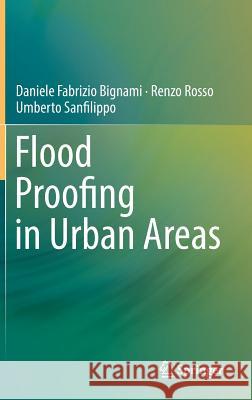Flood Proofing in Urban Areas » książka



Flood Proofing in Urban Areas
ISBN-13: 9783030059330 / Angielski / Twarda / 2019 / 268 str.
Flood Proofing in Urban Areas
ISBN-13: 9783030059330 / Angielski / Twarda / 2019 / 268 str.
(netto: 498,38 VAT: 5%)
Najniższa cena z 30 dni: 501,19
ok. 22 dni roboczych.
Darmowa dostawa!
Environmental and Land Planning Engineer and Ph.D., Daniele F. Bignami (National Scientific Qualification as Associate Professor, sector Urban and landscape planning and design) is at present in charge of the course Land planning for risk management of the MS of Architecture of the built environment at Politecnico di Milano, where he carried out teaching since 2006 in the field of Disaster Risk Reduction. Meanwhile he collaborated with the Italian Government - Civil Protection Department, and also with the Institute for an Industrial Safety Culture of Toulouse (France). Author of 3 books (and editor of 4 more) and author of more than 40 papers, mainly in the field of disaster management, built environment and urban issues, in 2005 he was hired by Politecnico of Milan Foundation as Research Project Manager, where he currently works, having gained experience from more than 40 projects achieved.
Civil Engineer and Ph.D in Hydraulic Engineering, Umberto Sanfilippo is full time Researcher at Politecnico di Milano since 2002. Currently he is in charge of the course of Hydraulic Structures of the Civil and Environmental Engineering first level graduation. He is also Head of the Flowmeters Calibration Service at the Laboratorio di Idraulica "G.Fantoli" of Politecnico di Milano. He is author and co-author of about 90 papers, most of them on urban drainage. He is also co-author of a book on real time control of urban drainage systems and a book on pumps and pumping stations. He has also worked on four EU research projects and eleven Italian national and regional research projects.
Flood control in urban areas can be feasibly and cost-effectively enhanced by implementing flood proofing approaches to risk reduction in the context of environmental and land-use planning and management. Indeed, flood proofing makes it possible to improve, integrate and in some cases even replace traditional measures for flood control, reducing the vulnerability and increasing the resilience of buildings and infrastructures.
This book begins by reviewing the physics of stability and instability of both human beings and buildings under flood conditions, together with criteria and models (both conventional and innovative) for assessing flood strains. In turn, it presents a range of flood proofing concepts and techniques, together with a complete and updated classification of related methods and devices. This provides a user-friendly tool to help identify appropriate solutions to real-world problems for each specific risk scenario.
In particular, the book focuses on temporary flood proofing techniques, given their ability to deliver effective performance at low costs. Lastly, it features an overview of norms, guidelines and laboratory recommendations that are currently being adopted in various countries with regard to flood proofing devices and testing procedures.
The purpose of this book is essentially to encourage authorities, stakeholders, technicians and end users to successfully develop flood proofing solutions that can reduce flood risk in a pragmatic manner. In addition, the authors hope to inspire researchers, manufacturers and designers (engineers, architects, urban planners and urban managers) to pursue further advances in this key sector of public and private safety in urban areas.1997-2026 DolnySlask.com Agencja Internetowa
KrainaKsiazek.PL - Księgarnia Internetowa









